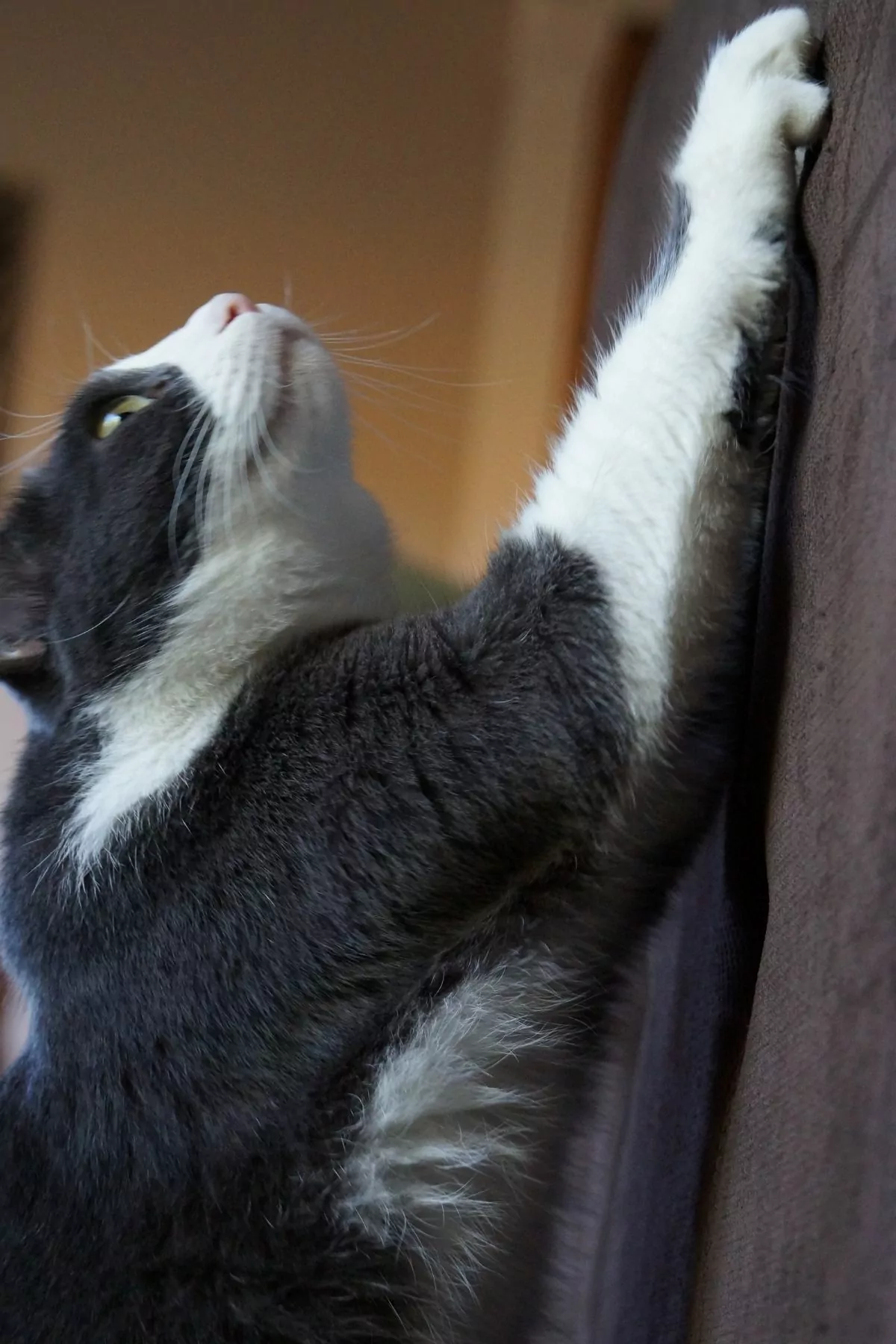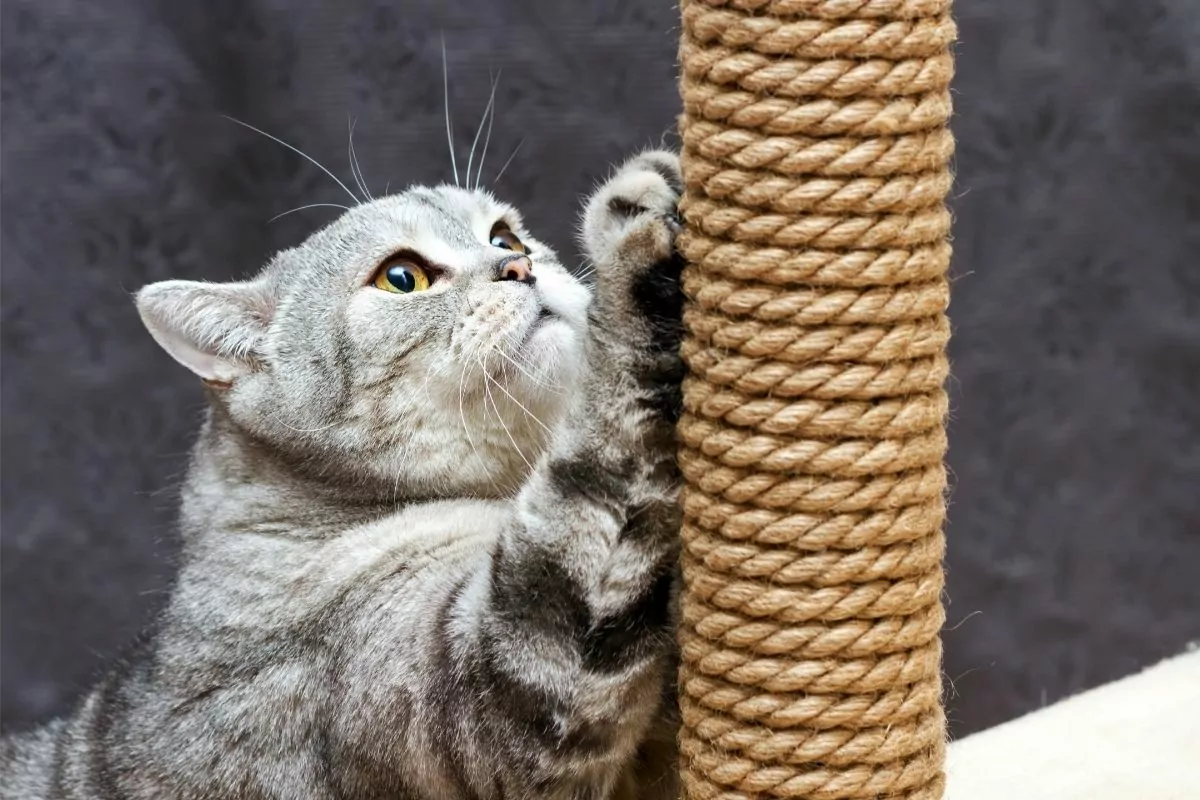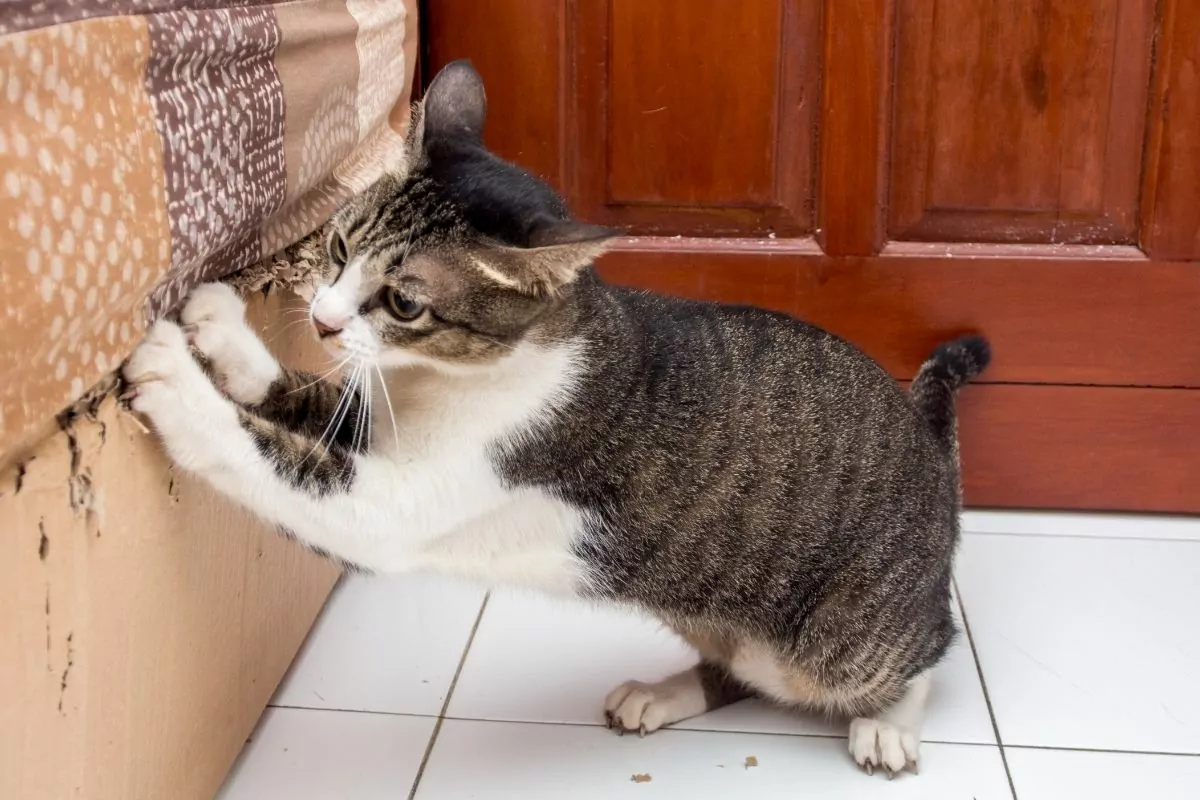Have you ever bought a new couch only to find your cat’s scratch marks on it after a few days? Yeah, we understand your frustrations. Now let us get into how to stop your cat from scratching your couch.
You spent a lot of money getting the couch, and because you love your cat, you cannot dispose of them. How about we tell you we had the solution to stop your cat’s couch disfiguring business in seven days. Yup, you read it right! How to stop your cat from scratching the couch with training for seven days? We’ll teach you!

Scratching the Itch
Have you ever had an itch you wanted to scratch so badly? What did you do? Usually, when animals itch so much, they would do anything to relieve the itch. It can be from throwing itself into water or sand, rubbing against furniture or any hard surface, or simply scratching if it can reach the itch.
Why Do Cats Scratch?
Before we start with the training, we need to understand or know why cats love to scratch.
Sometimes, it is not intentional to scratch your new couch, even though sometimes, it is intentional (to get back at you for sending them to the vet… just kidding). So why do cats scratch?
Cats scratch for these reasons:
- To sustain their claw health. Just as we file our nails to keep them clean and healthy, a cat scratches to keep their claws healthy by removing the outside nail husk.
- To stretch. Cats also scratch to stretch their muscles, tendons, and ligaments occasionally to prevent a stiff body.
- To de-stress. Scratching is a way of relieving stress and depression and makes them feel good.
- To secure territories. Did you know that your cat’s paw contains scent glands that are useful for marking territories? Scratching releases these odors from the scent glands, and it is a vital source of communication to cats.
What are the Best Cat Scratching Surfaces?
Surfaces that resemble what your cat likes to scratch are usually preferred by the cat, and it is the best. Some of these include sisal, carpet, cardboard, wood, and rope. When shopping for a post, make sure it contains at least one of these or what your cat prefers.
Also, consider how your cat scratches (whether vertically or horizontally). This would help you pick up the right surface for it.
There are three different types of cat condos for scratching: wedged, triangular-shaped ramps for cats that scratch low on furniture, an erect tree for those who like a full-body swing, and horizontal cardboard-like scratchers for those who like to scratch the carpet.
How Many Cat Posts or Scratchers Per Cat?
Ideally, you are to have one cat post per cat. However, considering your cat’s behavior and if it tends to scratch multiple places, you might need more than one cat post per cat. The posts should be placed at all the places your cat loves to scratch.
If you have more than one cat, you might need extra posts for sharing, especially for territorial marking. Therefore, the number of posts per cat depends on the personality of your cat and its behavior.
Do All Cats Scratch Furniture?
Yes and no. Cats simply love to scratch, and they can scratch anything they get their paws on. Cats scratch furniture because they like to scratch tall, sturdy objects with a soft material that enables them to dig their claws in, leave their mark and get a good grip.
Some cats also scratch carpets, drapes, and any other household materials that allow them to stretch fully, and get a good grip.
How to Stop Cat From Scratching Couch
If you catch your cat in the act of scratching, you should quickly stop it by giving a quick hiss or ah! You should be careful when calling your cat, use a gentle voice so that it doesn’t take your aggressive tone as punishment. Never mention your cat’s name when you are correcting him/her.
This should be used for praising only. This way, the cat won’t be scared and apprehensive anytime you mention its name.
There are two main methods to stop your cat from scratching your couch. They are known as the No and Yes methods.
The No Method
This removes anything pleasurable and appealing to the cat and replaces them with repulsive stuff. This would prevent your cat from scratching those things, leading to a stop in their reckless-scratching behavior. Before doing this, remember to provide your cat with a desirable place to scratch.
Some no methods you can do at home include but are not limited to the following:
- Set up a vinyl carpet runner, placing the spikes up the place they like to scratch.
- Cover the favorite scratch spot with a thin foil.
- Alternatively, you can cover the place with a double-sided tape foil.
- Cover your cat’s nails using a non-sticky, transparent plastic protector for your cat’s claw.
The Yes Method
This method, however, is to find a suitable place for your cat to scratch. Always remember to place these accepted scratch points near areas where your cat is more likely to scratch. Where does your cat like to scratch?
The best yes item to get your cat is a cat tree, condo, or cat/scratch post. They are inexpensive and easy to make if you would like a DIY. However, before you purchase or build any, put your cat’s preference in mind. These should be made of wood material as it mimics what they love to scratch most, trees, and should be covered with an appropriate covering.
Once these condos and trees are in place, attract your cat to it using its toys or by rubbing some catnip on it. Always praise your cat when they scratch the condos, so they attribute that to acceptable behavior.
However, be careful with the material you choose. If condos are made of carpets, your cat won’t understand why it is okay to scratch that and not your carpet. Wood is a safer option. Also, make sure that the post is strong enough to handle your cat’s weight and it is also not too small.

ILV’s 7-Day Cat Anti-Scratching Training Plan
Yes, the seven days sounds weird, and you are wondering whether you read it well. Well, you did. We are going to teach you how to stop your cat from scratching your couch in 7 days. Let’s go:
- 1st Day- Before this day, you should have located various scratch posts and interactive toys. Make sure the post you are going for is something that your cat would adore, and it is sturdy to take its weight. After you have decided on the post, purchase it.
- 2nd Day– Now, place the various cat scratch posts at vantage points, where the cat is most likely to scratch and see it. For example, put one near its bed, as they like to stretch and scratch as soon as they wake up. Also, do not place the cat post in a corner, but let it be visible as it is used for territory marking. Praise your cat and give treats when you see them using the post.
- 3rd Day– Make sure the couch is unattractive to your cat. You can cover it with a foil or a cloth or even spray citrus, rosemary, thyme, lavender, banana, mustard, or eucalyptus-based perfume on the couch to repel it. The spray makes them think they have already marked that place and won’t return to remark on it.
- 4th Day– Encourage your cat to get interested in the cat post by sprinkling catnip on it. Catnip is known to calm the cat and give them a feeling of euphoria. Alternatively, you can also sprinkle honeysuckle on the post, as the smell attracts them to rub against it.
- 5th Day– Spark up your cat’s interest by using a toy by the post to catch its attention. Once you have your cat’s attention, drape the toy over the post so your cat plays with it. Also, ensure that the post material is something that your cat enjoys scratching.
- 6th Day– If your cat is still scratching your couch or other undesirable places by which they shouldn’t, try spraying the house with cat pheromones to relax them and keep them calm. This should help if the cat scratches as a result of stress. Remember to hang out with your cat near the post and reward them with treats and praise when they use the post.
- 7th Day– On this day, God rested, and so should you. By now, your cat should be using the scratch post. Don’t forget to keep the praise and treats coming to continually motivate it. Also, anytime a new item comes to the house, ensure your cat knows this is not a scratching post by using whatever method on the 3rd day that worked.
We hope you will be smiling with us by the end of this 7-day training.
Why is Declawing Not an Option?
If your cat keeps destroying your furniture, why not cut out its claws altogether? After all, it lives with you, and it does not go hunting.
Declawing, medically called onychectomy, is a surgical procedure where the cat’s claw/nail is removed but not only that. Declawing is inhumane because it doesn’t just cut out the claws but also cuts out the digits up to the first joint of the fingers. Now, that is amputation. In addition, the declawing process is painful and has many complications associated with it.
It distorts the balance of your cat, changes how it responds to its environment and how it walks altogether. Your cat will have to live indoors for the rest of its life and will have issues with using the litter box. This is because the front claws are the source of defense for the cat against predators. The declawed cat will also tend to be aggressive.
What are the Alternatives to Feline Onychectomy?
If declawing/feline onychectomy is such a bad thing, then what other alternatives do we have?
Alternatively, you can always trim your cat’s nails regularly to avoid using them to scratch. You can also provide scratching pads for your cat at various places around the house. Also, you can speak to an animal trainer concerning your cat’s behavioral issues.
You can speak to your veterinarian or groomer to install soft paws/soft claws. This is a nail cap placed on top of your cat’s nails. If you choose this method, you can learn how to install them yourself with time. The disadvantage with this is that a new nail pushes the nail cap off, and thus, new ones have to be installed, making it more costly but more humane.
Another thing to consider is using sticky paws. It is a scotch tape with a double-sided sticky part. You stick one end onto the furniture, and the other end gets attached to your cat’s paws when they attempt to scratch. Don’t worry; the glue is safe for the furniture and does not leave any marks or tears. You can also get cat mittens for your cat to prevent the claws from sticking out.
The Dos and Don’ts of Cat Scratch Training
We know that you are frustrated and want this behavior to stop. But be careful, as you might worsen it all together. Here are some of the things to do during the cat scratch training:
Do’s
- Ensure that there are different cat scratch posts with different textures, shapes, and sizes to determine which one your cat fancies. Once this is identified, provide several such posts at vantage points in the house.
- Discourage your cat from scratching at the wrong places by putting the cat posts at the places where they are likely to scratch. Alternatively, cover up the undesired places with cloth, foil, or spray citrus, lavender, etc., over them.
- Encourage your cat to use the post by hanging toys over them, spraying with catnip and honeysuckle, and placing them where it is most likely to see them.
- Always make sure your cat’s nails are trimmed regularly, or put soft claws on them if you can’t trim them.
- Cats begin to scratch from 8 weeks old. This is the time to provide scratching surfaces and train your cat to start using them.
Don’ts
- Do not discard scratched, worn-out posts as they smell familiar to the cat, and they can get their claws into the material, something they are passionate about.
- Do not shout or scream at your cat when they are scratching at the wrong places, as this would scare them. Instead, gently make a hissing sound, clap your hands, or squirt a little water in their direction to make them stop.
- Also, do not force your cat to scratch on a post by dragging it to the post and pulling its claws over it. This is frightening, and they might shy away from the scratch post altogether.
How to Trim Your Cat’s Nails
Trimming nails can be stressful not only for the animal but also for the human, especially if you have an uncontrollable animal. To trim nails:
- You need to make sure the animal is comfortable. Nail trimming is not a natural phenomenon. Therefore try to make it as stress-free as possible. That way, your animal attributes it to something good.
- Also, since nail trims are not a natural phenomenon, it is advisable to start young. This way, they get accustomed to it.
- Always ensure that your clipper blades are sharp to avoid causing pain and splitting the nails.
- Ensure that you cut just the tips of the claw/nail. Each nail has a clear part and the pink part. This is most obvious with cats with clear/white nails. With such nails, the tip, which is the clear part, is what is used for the damage of scratching. Therefore, that is the part you should cut. For cats with black nails, the clear part is challenging to see; hence, the nails should be trimmed just at the tip always.
Remember that nails are a living part of the body with blood vessels and pain sensors running through. Therefore, if you cut too low to the point of bleeding, your cat would associate nail trimming with pain, and it would be difficult to get any trim done.
- You can equally cut the nails when the cat sleeps during the day. With cats being nocturnal, you can be rest assured that they would be napping a lot during the day. However, with this method, you have to be quiet and fast. As soon as the cat wakes up, stop and wait for another opportunity to reduce stress.
- Lastly, you can also get stress relievers and calming medicines, sprays, and other substances that help your cat keep calm and reduce anxiety when cutting the nails.

What to do if Your Cat Won’t Stop Scratching
If your cat doesn’t stop scratching, there are other ways to curb this problem. Contact your veterinarian or animal behaviorist after trying all the given methods, and your cat is still scratching. Do not let this natural behavior get in the way of your relationship with your cat.
Remember that there is always a solution to every problem.
